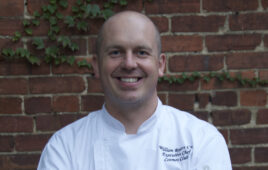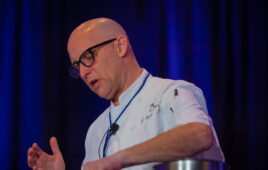In a self-described rant posted on Buffalo Eats, James D. Robert, Executive Chef at Park Country Club in Williamsville, N.Y., discussed the dangers of “going big” in fine dining.
“We, as Americans, are a nation of consumers, no doubt,” Robert wrote. “We tend to like things big: big cars, big coffees, big houses, big buildings, big sodas, big macs, big deals, big flavors, and big entrée portions. These last two are the ones that concern me most as a chef.”
Robert describes a tendency for people in the Buffalo, N.Y., area to be more impressed by the size of entrees, specifically a “proper Buffalo fish fry,” that literally “hands off the edge of the plate—all for $9!””Do you really think bigger is better? Wouldn’t you rather have a smaller piece of something remarkable? And who needs 19 ounces of fish for dinner, especially 19 ounces of crap fish? Why are we so enthralled by size? Quantity over quality—it hurts me.”
But big entrees aren’t the only issue, Robert wrote, adding that young chefs in particular prefer to pile on a slew of ingredients to create big flavor, overwhelming the basic components of the dish.
“Do you know that each cut of pork has its own taste? Or that each breed of pig has its own unique flavor? How about just cooking the pork chop perfectly and leaving it as is? I bet if you paid a little more for that pork chop, you wouldn’t have the need or the money available to drown it in your saucier sorcery.”
Those who truly suffer from these sins, Robert wrote, are the diners who are entrusting culinary professionals to impart their knowledge. Quality ingredients trump overwrought concepts and concoctions every time.
“In our region, we have some of the most amazing products in the world available to us at our disposal. Do you think a chef at the foot of Mount Vesuvius in Italy is wasabi beer battering his fresh summer tomatoes and stacking them with blackened chicken and pickled onion goat cheese balls held together with a flaming sprig of rosemary? No way, he is serving those tomatoes just as they were intended, perfectly room temp, maybe even on the vine, with perhaps not even salt, or maybe in an “as perfect as perfect gets” caprese salad—simply.
“Once you have acquired fine product, and mastered the art of gently coaxing its natural flavor to the forefront to the delight of the waiting palates of your trusting patrons, then, perhaps, you can dabble with some complementary flavors and build a composition that highlights (but doesn’t mask) the ingredient. Mind you, that does not mean you should pile these flavors on. Instead you should lay them, ever so gently, next to one another, producing a harmonious symphony of flavors that the guest will savor with each bite, slowly discovering all the possible combinations until the dish has been devoured. Then more is not more, or even too much, but just enough, and even then, could assuredly be less.”
On a final note, Robert wrote that tasting menus should comprise of components that, when combined, fit onto a single appetizer plate and a single entree plate, rather than seven full-size entree plates.
“That’s why it’s called a tasting menu.”


